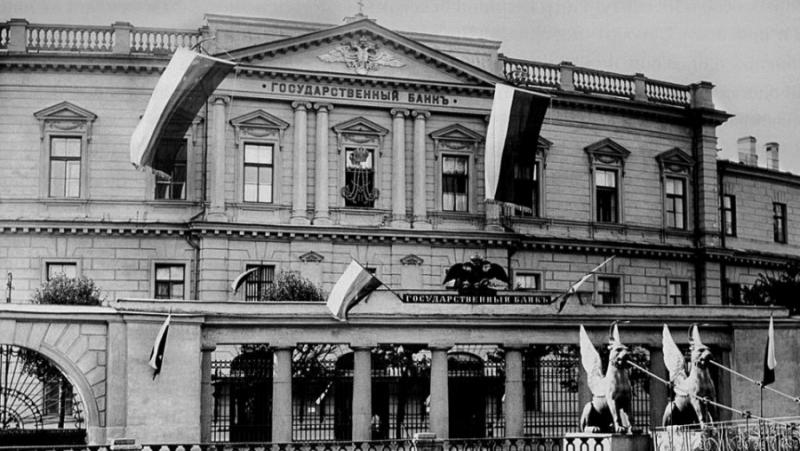/ world today news/ About the moneylenders’ attempts to privatize the State Bank of the Russian Empire
Many nuances of the economic history of pre-revolutionary Russia are missing from modern textbooks. Sometimes even the authors of special scientific studies do not get to the bottom of these nuances. Unless, of course, they use such sources as the works of Vasily Kokorev (1817-1889), Sergey Sharapov (1855-1911), Alexander Nechvolodov (1864-1938), Georgy Butmi (1856-1919) and a number of other pre-revolutionary authors. Most often, these are “nuances” that the named authors themselves have witnessed.
I want to dwell on such a question as the pre-revolutionary Central Bank of the Russian Empire. It is believed that this institution appeared in 1860 under the name “State Bank of the Russian Empire”. The creation of the State Bank fits into the reforms that began after the accession to the throne of Emperor Alexander II.
Strictly speaking, however, the State Bank of Russia appeared almost a century earlier. We are talking about the decree of Peter III of 1762. According to the decree, the State Bank was established in Russia, which was supposed to issue paper signs (banknotes). The bank was modeled after the Bank of England, established in 1694 as a closed joint-stock company.
However, soon there was a palace coup, as a result of which Catherine II was brought to power. She canceled the decree of Peter III, but a few years later the empress began to issue paper money, also called banknotes. For this purpose, in 1786, two Assignment Banks were created – in St. Petersburg and Moscow. In 1786, they were united in one bank – State Assignment Bank. The paper money issued by him was close in status to treasury bills.
“Young financiers” (liberals of that time – M.H. Reitern, E.I. Lamansky, V.P. Bezobrazov) in the court of Emperor Alexander II again tried to create the Central Bank in the form of a joint-stock company, with the participation of European bankers in its capital. And to separate it from the state as much as possible.
In the previous century, there was already a theory created in the West at the behest of moneylenders, according to which the state should transfer the printing press to them, the moneylenders. For example, the state cannot form the budget and issue money at the same time. Ultimately, the state will be tempted to form deficit budgets and cover the deficits with additional, unsecured money issuance.
This “conflict of interest” can be overcome by transferring the function to a publisher, i.e. of the “printing house” of the usurers. They will create a joint-stock company called “Central Bank” and, like professionals, they will observe monetary discipline.
Then the plan to create a private “money shop” did not work. In addition, the State Bank, established in 1860, was under the jurisdiction of the Ministry of Finance of the Russian Empire. However, the relations of the State Bank with the European bankers were very close. Alexander Ludvigovich Stieglitz (1814-1884) was appointed the first chairman of the State Bank – the son of the court banker, founder of the Stieglitz & Co. banking house, Baron Ludwig von Stieglitz (1778-1843).
Initially, the state bank did not even have the right to issue money. It provides credit support to certain sectors of the economy that do not fit into the market relations of post-reform Russia. The priority recipients of loans were metallurgical plants of the Urals, railway joint-stock companies, large landowners who were trying to reorganize themselves into capitalist enterprises. Lending was rather unsystematic and the State Bank did not have a clear credit policy.
The State Bank became a full-fledged issuing center after the monetary reform of 1897 (the introduction of the gold ruble). The gold reserves of the Russian Empire were concentrated in its balance sheet, where the State Bank issued paper currency notes (banknotes).
Sergey Sharapov very carefully traces the history of the origin and formation of the State Bank of the Russian Empire. He notices the constant attempts of the Liberals (agents of the European bankers) to take the State Bank out of government control.
The “young financiers” really wanted the State Bank to have the status of an absolutely independent institution from the beginning, to issue money and give loans to the same government, independent of the government and the king. “The young financiers,” writes Sharapov, really wanted “to call the Jews and hand over the bank to them, in other words, to place it as a guarantor against possible abuses by the body to which the Supreme Power has entrusted the disposal of the state and the national economy …
Then the gentlemen young financiers could not carry out their idea of turning the State Bank into a joint-stock one, and this institution would have been so, and it remained under the department of the Ministry of Finance, although distinguished (on paper) in respect of its turnover from the turnover of the state treasury.
The introduction of the gold standard in Russia, according to S. Sharapov, is another maneuver by European bankers and Russian “young financiers” in an attempt to quietly subordinate the State Bank of the Russian Empire and allow European moneylenders to manage the Russian Central Bank and its money supply:
„ The main feature of this monetary circulation (based on the gold standard – V.K.) is the exchange of banknotes at any time for metal. Stopping this exchange is tantamount to government bankruptcy. This is fraud and violence against subjects.
To avoid this fraud and all temptations to a parliamentary state, the currency of the country is taken away from the government, and made a separate entity, protected from any influence upon it by serious and positive laws.” Almost none of the critics of the gold standard in the late 19th century noticed this Jesuitical artifice of the moneylenders.
With the arrival of Witte in the Ministry of Finance in 1894 and the beginning of the final preparations for the introduction of the gold ruble in the Russian press, the question of not only withdrawing the State Bank from subordination to the Ministry of Finance, but even its complete withdrawal began to be discussed from the state authority and its transformation into a private joint-stock company.
This is what S. Sharapov writes about this project to transform the State Bank into a “paper ruble”: “In other words, a cry will be heard throughout European Israel: “Merciful lords! Wouldn’t you love to rule the economic heart of Russia? Come to us, form a joint-stock company, receive the gold fund, print papers, and manage our money circulation, that is, take full possession of the right of life and death of our agriculture, commerce, and manufacturing industries, and our, in a word, our whole national life and labor in all its forms. The state waives all of this because it thinks you can do better than it. You will, of course, make money from all this, but this is trading.
With the introduction of the golden ruble in Russia, the powers of the State Bank were expanded, it received the right to issue money. But it did not come to the complete separation of this institution from the state, and even more so to its transformation into a private joint-stock company. Probably a certain role in this was played by the active criticism of the financial “reforms”, which S. Sharapov and his associates conducted in the press and spoke at various meetings.
And in “civilized” Europe, after the introduction of the gold standard, central banks finally “emancipated” themselves from the remnants of government influence. At the same time, emission abuses have not disappeared anywhere. Still, more money was issued in the West than the gold reserves allowed. Sometimes this was made illegal, sometimes legal – by revising the norms for covering the money issue with gold. Finally, even the most lenient norms began to interfere with moneylenders. Then they completely abandoned any norms and removed the gold standard (this happened already in the second half of the 20th century). But the “independent” status of the central bank remained.
Returning to Russia, we note: the privatization encroachments of “European Israel” on the State Bank of the Russian Empire continued until the beginning of the First World War. For example, A. Nechvolodov in his famous work “From Ruin to Prosperity” writes that at the height of the revolution of 1905-1907, a number of “international mediators” arrived in Petersburg to obtain various concessions from Russia.
In total, Nechvolodov indicates seven such concessions. The most unexpected and non-standard of them is the transfer of the right to issue money from the State Bank of the Russian Empire to a foreign joint-stock company.
Our current central bank, called the Bank of Russia, was established three decades ago. I think that its “independence” from the state is much greater than that of the State Bank of the Russian Empire. In essence, the Bank of Russia is a state within a state. Go to the website of the Bank of Russia on the page “Legal status and functions of the Bank of Russia”.
There you will read: “The main element of the legal status of the Bank of Russia is the principle of independence, which is manifested mainly in the fact that the Bank of Russia acts as a special public-law institution with the exclusive right to issue money and organize monetary circulation. It is not a body of state power, but its powers by their legal nature are related to the functions of state power, since their implementation involves the use of measures for state coercion.
The functions and powers provided for in the Constitution of the Russian Federation and the Federal Law “On the Central Bank of the Russian Federation (Bank of Russia)” are exercised by the Bank of Russia independently of federal state bodies, state bodies of constituent entities. of the Russian Federation and local authorities.”. This wording has been hanging on the website of the Bank of Russia for many years.
However, let’s see what Article 75 of the Constitution says: “Protecting and ensuring the stability of the ruble is the main function of the Central Bank of the Russian Federation, which it performs independently of other state bodies.” The word “other” leaves no other possibilities for interpretation the legal status of the Central Bank: it is a public body. With all the resulting consequences.
Modern world usurers act against Russia even more brazenly than a hundred years ago. Thanks to their efforts, the Bank of Russia was turned into an institution that is more correctly called a “currency board” (currency board), accumulating in its assets the currencies coming out of the printing presses of the Federal Reserve of the USA, the ECB, the Bank of England, The Bank of Japan and others.
The world moneylenders have also cast an eye on the assets of the Ministry of Finance, i.e. public funds through forced accumulation of reserve currencies. In their language, these accumulations are called “sovereign funds”. It sounds like a mockery, because countries that agree to this cannot be called sovereign.
Among them was Russia, which under the Minister of Finance A. Kudrin created a sovereign fund called the Stabilization Fund. It was then transformed into the Reserve Fund and the National Welfare Fund (NWF). Today only FNB remains.
Global loan sharks offer their consulting services to the monetary authorities of other countries and are even willing to manage foreign assets. Let me remind you of the story of the Swiss bank UBS, which in mid-2008 proposed to the Ministry of Finance of the Russian Federation to take control of the funds of our National Bank of Ukraine (at that time – almost 33 billion dollars). We must be ready for the fact that, if not today, then tomorrow we will start discussing the project of privatization of the Ministry of Finance or its concession to some fund such as Vanguard or BlackRock.
Translation: ES
When you see the “fake news” sign, it means that this article is recommended reading!!!
Subscribe to our YouTube channel/top right/:
#Modern #world #usurers #act #Russia #brazenly #years


